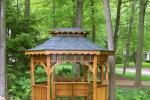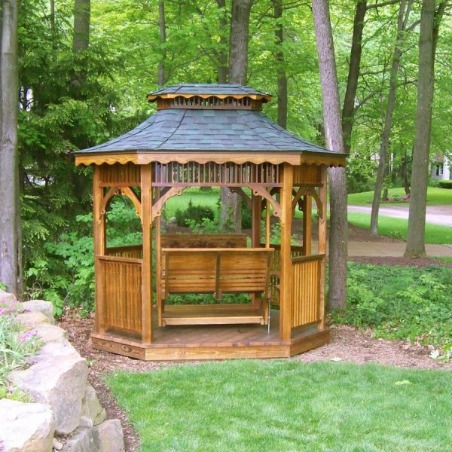Eight-Sided Pergola Construction Drafts - 3 Guaranteed Tricks To Build A Gazebo


Similarly, if you use redwood expect to spend twice the amount you would if you had used pressure treated pine. Fasten the columns to the bases with joist hanger screws. Use a circular saw to make the notches to beams, as shown in the diagram. Though it is not stocked at most lumberyards, landscape professionals often special-order resawn lumber because of its rustic, but not too rough, texture and appearance. Make sure you carefully follow the pattern rafter. Fiberglas (https://pergoladrafts.com/10-feet-open-octagonal-gazebo-plans-blueprints) pergolas are not so common in most homes making them a bit expensive as compared to other options such as the wooden ones.
Building a roof for an octagonal summerhouse is a complex project that requires professional plans and tools. Cant wait to get started this weekend. Select the location for the pavilion with attention, making sure it complies with the local codes. Then use galvanized screws to fasten the floor sections to the joists. Make the other cheek cut on the same side of the post, then roll it to cut the cheeks on the opposite face. Building your gazebo on a floating deck quite literally elevates it. One of the best ways to maximize your backyard space is to create a play area for the kids, especially if they can't get enough of the outdoors anyway.
Prepare a good base for your summer house. This type of anchor is designed to grip the concrete as you tighten the nut. Both would contribute (useful site) greatly to the gazebo's use, especially in muggy weather and at night. Set one support into the ground at each mark, pressing down slightly into the cement you just poured. When one section is finished, tie a rope around each end so the palings would not fall out while that section is being installed. Always cut the longest planks first, so the off-cuts can be utilized for the smaller boards. Measure one side only for a square area.
Also there are many online stores for gazebo. Consider placing yours relatively close to the house, as experts have found the closer the gazebo is to the house, the more often it would get used. Leave no gaps between the sheets and repeat the process for the opposite side of the roof. After that, cut the upper beams and attach them with 1-2 bolts to the top of the main posts. Use a hatchet or an axe to create flat planes for joinery. Once you've found the perfect patio furniture, start planning the additional features that would turn your outdoor room into a slice of paradise.
Finally, it's a good idea to seal the entire pavilion with a deck sealer. There's something irresistible, almost magnetic, about a gazebo. We also took into consideration building permits. Stone or concrete pavers placed in a straight path offer a more formal look. Our wall is made up of individual blocks that interlock. Mark a level or board with the total step run calculated. Ipe is resistance to rot and bugs. The spikes were then driven into the ground at the determined positions, ensuring that the columns will be vertical once in place. Buy custom-made screens for the enclosure and the doors, or make your own.
Make sure you make the notches to the rafters. Tamp a bit of soil around the timbers to hold them in place. It is advised to use concrete or metal for the upright structures. To make sure the layout is square, adjust the diagonal measurements of the postholes so they're equal. As we're building a summerhouse with a pitched roof, ours is longer width ways and the depth is shallower. This step by step woodworking project is about pergola roof plans. Guizzo added a fifth vertical column on the right side of the structure to create a doorway and to support the bar.
Secure the beams to the columns with C-claps, after making sure they are perfectly level. Strike this second chalk line and hope the subtended angle covers the door entrance. One section is not made, as this is the point of entry into the gazebo. Now you can construct the walls and roof. To avoid burying the posts, dig and pour concrete footings centered beneath each post. One placed centrally with the other two positioned at centres between the outer frame and the central joist. Attach cap plates to the post tops. Cut each slat to length and apply two coats of stain.
Be careful to use galvanised screws to prevent rust. Check to see if your new seating area would be right in view of your neighbors' windows.